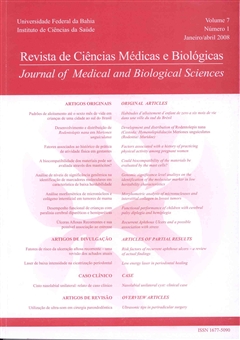Could biocompatibility of the materials be evaluated by the mast cells?
DOI:
https://doi.org/10.9771/cmbio.v7i1.4355Keywords:
biocompatibility, mast cells, eggshell membrane.Abstract
The main objective of this research is to study the role of mast cells in the process of wound healing considering its presence in the creation of an assessment criteria and interpretation of biocompatibility in tissue response. The experiment had been managed in forty Rattus norvegicus albinus divided randomly into four grups (1,2,3 and 4) for evaluation in 24 hours, one, two, and three weeks, respectively. Each animal had been provided for the experiment goups (dorsocephalic region) and a biocompatible membrane had been inserted in the subcutaneous connective tisue and sham control (dosocaudal region) where the connective tissue had been only manipulated. The results asserted that in the experiment groups, the amount of mast cells in the tissue had been lower than in the respective sham groups, however the comparation with the amount of these cells have not shown any statistic relevance. The statistic values found for p=0,05%, using the “t” test by Student, comparing each experimental group with its respective sham, had been of: group 1 (p=0,218), group 2 (p=0,421), group 3 (p=0,116) and group 4 (p=0,668). In a nutshell, not very statistically significant. The values between the 24-hour sham group and the experimental three-week group had been of p=0,014 and the comparison between the experimental 24-hour group and the three-week sham group had been of p=0,001. The conclusion is that the presence of mast cells in adjacent areas of the membrane proposes a non-rejective response. However, new researchs must be done in order to clarify the viability of inserting those cells in secundary biocompatibility tests.Downloads
Download data is not yet available.
Downloads
Published
2008-10-15
How to Cite
Oliveira, M. Q., & Sadigursky, M. (2008). Could biocompatibility of the materials be evaluated by the mast cells?. Journal of Medical and Biological Sciences, 7(1), 32–39. https://doi.org/10.9771/cmbio.v7i1.4355
Issue
Section
ORIGINAL ARTICLES
License
The Journal of Medical and Biological Sciences reserves all copyrights of published works, including translations, allowing, however, their subsequent reproduction as transcription, with proper citation of source, through the Creative Commons license. The periodical has free and free access.


